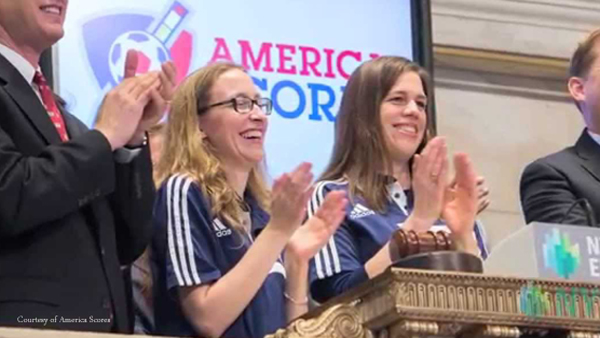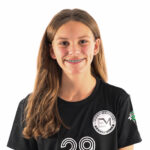SoccerWire Q&A: America SCORES Executive Director Holly O’Donnell

PHILADELPHIA — Amidst the legions of soccer coaches that descend on the NSCAA Convention every January, there are also a number of charitable and non-profit organizations who use the sport for good in communities that are not as fortunate as others.
 One of those organizations is America SCORES, founded in 1994 in Washington, D.C. by Julie Kennedy, a public school teacher at the Marie Reed Learning Center in the northwest of the city. It began as a girls-only program, and provides youths in urban areas with after-school programs in arts, athletics and academics to make them more rounded individuals.
One of those organizations is America SCORES, founded in 1994 in Washington, D.C. by Julie Kennedy, a public school teacher at the Marie Reed Learning Center in the northwest of the city. It began as a girls-only program, and provides youths in urban areas with after-school programs in arts, athletics and academics to make them more rounded individuals.
SoccerWire caught up with Holly O’Donnell (pictured above, right), the national executive director of America SCORES, for a chat about the organization’s work and their involvement in soccer across the country.
SoccerWire: America SCORES works with urban youth, what do you aim for in the program and what are you looking to do?
Holly O’Donnell: America SCORES is a national after-school program and we have 8,000 low-income youths in the program. We are aiming to make sure these kids have the skills and experiences that they need to be successful in school now and in life. One of those top things is that they’re healthy, so we do that through soccer.
SW: America SCORES does a lot of different things — poetry, creative writing and more. How did you reach the decision to use all these different aspects?
HOD: America SCORES started in Washington, D.C. 21 years ago and it started really organically with one public school teacher who started noticing that her girls — it started as a girls-only program — didn’t have anything to do after school. It was before a report came out that said all these dangerous things happened after school like gang activity and teen pregnancy. She went to her own skill set, which was soccer, then it got cold and the girls kept coming, so she turned to another one of her skill sets, which was writing and poetry.
It was a very organic start and what we found over the years is that whether you look at it as healthy mind, healthy body, but more important are those peer-to-peer connections that the students make as a team. They are a team after school on the soccer field, and they are a team after school in the classroom.
SW: Why soccer, was it purely because it was in her skill set? Over the years, as the program has evolved, why have you stuck with soccer?
HOD: We have stuck with soccer for a lot reasons. One is that when this program started, we were really at the forefront of bringing soccer to the inner cities all over the country. Number two, it is a really acceptable sport. Three, for the type of communities we’re in now, we have a lot of immigrant children and so it’s something they can connect with.
We just found that with the communities that we’re working in, we become the soccer league for these public school districts that in this climate of budget cuts they wouldn’t have otherwise. The kids do play games against each other, it’s not just clinics. For us, we really are a league of the public school districts that is funded from other sources.
SW: How do you find that soccer translates into the urban environment?
HOD: I think it translates really well, but you have to provide the opportunity. When we’re talking particularly about African-American communities, a lot of kids we’re introducing soccer to that community. However, we also work in predominantly Latino communities, where obviously it’s a part of their culture. It depends, I think when you’re working in an urban environment you’re facing issues that the suburban clubs aren’t, particularly related to field space, to resources for uniforms, so that’s why you need programs like America SCORES and other ones that provide those types of support.
“In terms of talent, and we know it’s there, it’s providing the network of support for the kids that might not have a two-parent income and someone that can drive them around all over creation.”
When we first started this program, there weren’t that many adults that were playing soccer, so we had to do a whole different type of training, and now because we hire and train teachers from the schools, we find more and more grew up playing soccer, so that is really nice. Before, one of the main things about the urban environment was finding coaches. It’s easy to introduce a sport to kids, kids are pretty open-minded, but finding someone to coach a sport that they don’t know, that was trickier than with the kids.
SW: How do you go about overcoming challenges such as space, lack of resources? How do you make it work?
HOD: We are always fundraising. Around the country, one of our most successful fundraisers is called the Corporate Cup and it’s a corporate soccer tournament and we have companies from Google to PWC participating. When you’re a nonprofit and you’re trying to raise money, doing things that align with your mission make sense. We have that good fortune. That’s one way.
 Another way is we have a national spokesperson, Brianna Scurry, who’s great. She helps us elevate this issue in the role, and is really critical. We have a really dedicated smart team, people who have been around, we have very low staff turnover. And now we have data and alumni that can tell the story themselves and prove in numbers that the program works, which makes it easier to stick around.
Another way is we have a national spokesperson, Brianna Scurry, who’s great. She helps us elevate this issue in the role, and is really critical. We have a really dedicated smart team, people who have been around, we have very low staff turnover. And now we have data and alumni that can tell the story themselves and prove in numbers that the program works, which makes it easier to stick around.
SW: Do you find people respond well to Brianna Scurry and your alumni when they share their stories? Do you find kids can relate to that?
HOD: I do. We work hard to bring role models in, whether or not they’re World Cup champions or people from their own community who have gone to college. It’s really about the values of the organization, teaching kids from a young age about teamwork, leadership, commitment, and making sure that’s consistent throughout the program and I think in our communities one of the biggest success is that we stay in schools and in public education.
Principals come and go and curricula come and go and initiatives come and go. The first school that we were in 21 years ago, we’re in today. To make it work in San Francisco, they’ve built fields on asphalt, so once you are more established, you can get beyond just the programming and figure out how it can be sustainable and improve the community beyond the program. It takes time.
SW: What have you made of the growth of interest in soccer in this country? You were ahead of the curve in many ways.
HOD: It’s been great for us, I think the same type of explosion that’s happened has not happened in the urban areas, and it’s going to take the suburban and urban soccer players really figuring out how those partnerships can happen, because if you’re talking in terms of talent, and we know it’s there, it’s providing the network of support for the kids that might not have a two-parent income and someone that can drive them around all over creation are going to need to be successful.











